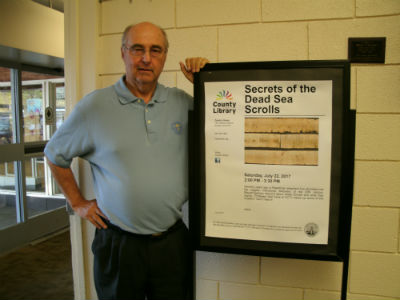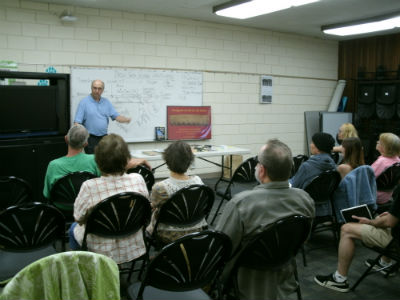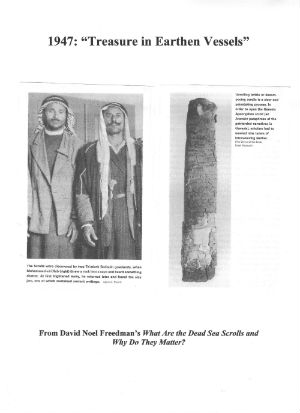The Adventure of the Dead Sea Scrolls
By Neil Earle

Seventy years ago, in the spring of 1947 a Bedouin goat-herder named Muhammed the Wolf scouting his charges threw a rock into a defile in the Dead Sea area and heard a clunk. Inside he found stone jars wrapping some non-descript items in leather. Thus began the legend of the most significant Biblical discovery of the Twentieth Century: the manuscripts we know as the Dead Sea Scrolls.
On Saturday July 22 at the Duarte Public Library I was fortunate to present a talk on these fascinating manuscripts (MSS). Their very subject evokes mystery and romance but their importance for Jews, Christians and Muslims who venerate their special books is sometimes lost.
No wonder. For the first years no one seemed to know what to do with them. One story goes that Muhammed wanted to keep the leather enfolding the documents for fixing sandals. In 1948, however, the Bedouin approached an antiquities dealer in Bethlehem who could not decipher the letters written on the scrolls. It wasn’t Arabic. He turned them over to the Syrian Orthodox leader in Jerusalem for verification. The bishop also felt bemused and sent them to John Trever of the American School of Oriental Research in Old Jerusalem for help.
Trever photographed a section and sent it to the leader of Biblical Archaeologists at that time, William Foxwell Albright at Johns Hopkins University. Albright wired back – “Congratulations on the most important discovery of the century.”

The Legend Grows
But then the first Arab-Israeli War broke out in 1948 and the Bishop sent them to Lebanon for safe keeping. Many were skeptical about the authenticity of the artifacts. Nevertheless an international team headed by Roland De Vaux excavated the Dead Sea area around Qumran and worked on the delicate MSSs coming to light. By 1956, 11 caves containing 10 whole books and thousands of fragments from the period 200 BC to 68 AD were uncovered.
Jordan controlled this region at the time and watched the process of transcription carefully and it was hard to find scholars competent to do the work. All sorts of rumors emanated from the Holy Land. Had the Scrolls contained something to contradict Judaism? Were they showing something that would overthrow Christianity? Were there legends about Jesus marrying Mary Magdalene?
None of this was remotely true. What had been uncovered were three main categories of manuscripts apparently from a monastic-like community near the Dead Sea. They had fled what they felt was the corrupt Jerusalem Temple to transcribe their own copy of the Jewish Old Testament. There were dozens of hymns and devotional books and Jewish historical books as well.
What was the upshot of all this? Scholars had known for years that the Old Testament in our English Bibles had been based on a Leningrad Codex from 906 AD. It had been transcribed from a group of Jewish scribes who guarded the authentic Jewish text for 500 years and a line of copiers going back to those who had fled the Roman destruction of the Temple in 70 AD.

Checking the Checkers
How good was their work? Were there major mistakes and prejudicial interpretations? The new Dead Sea Scrolls offered experts a chance to check on our Hebrew-to-English Old Testament back by over a 1000 years. At stake the question: How good was the Jewish work on our Old Testament across the whole first Christian millennium?
A 1954 ad in the Wall Street Journal made selected Dead Sea MSS available and the Israelis became interested, building the Shrine of the Book in 1965 to house the well-preserved Book of Isaiah from Cave 1. When Israel captured the Dead Sea area in the Six-Day War of 1967 it was expected that the Scrolls would at long last be more available to Western scholars.
Due to the delicate conditions of the documents it still took a while until digital copies became generally available in the 1990s. Claremont University has a complete set on carefully done photographs.
So why all the fuss?
 Why do they matter? Handout from lecture at Duarte Public Library asks the relevant question. Click photo to enlarge.
Why do they matter? Handout from lecture at Duarte Public Library asks the relevant question. Click photo to enlarge. Skill of the Scribes
Remember the oldest official Jewish copy of our English Old Testament had been composed in 906 AD. The Dead Sea Scrolls showed a remarkable agreement with what was in the Hebrew Bible. This is the crux: the scrolls underscore the skill of the Jewish scribes who fled Jerusalem after the Roman destruction in 70AD and their work down to 906. We have reliable reports as to the skill of the last era of Jewish copiers known as the Masoretes from 500-906. The word “massorah” derives from the Hebrew word “to hand something down.” Just a brief glimpse shows why the Scrolls and the Jewish “Masoretic Text” behind our English Old Testament are in such good coherence.
The rules for transcription were first-class, professional and rigorous. The Masoretic copiers calculated the middle letter of the Hebrew Bible, the middle letter of each book, the middle verse of each book, while phrases such as “House of Israel” were computed separately from “sons of Israel.” And this is not half the story. One scholar said, “Just about everything that could be counted, was counted.” Albright praised the Masoretes for “an accuracy unparalleled in any other Near Eastern literature.”
So paradoxically, it is better to judge the Dead Sea Scrolls by the Masoretic Text than vice versa. Our English Bibles preserve in substantial degree the Old Testament as it was in the time of Jesus and the apostles. And that is a part of the adventure of the famous Dead Sea Scrolls.